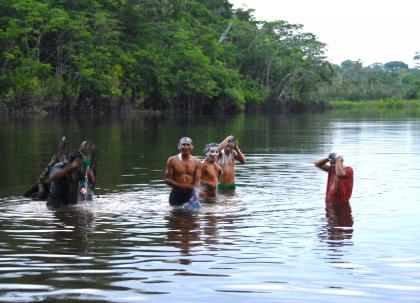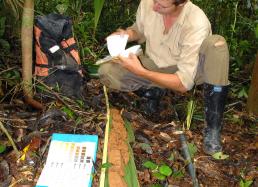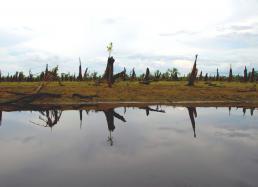4. Camp 1: Clay Soils & Blackwater Lakes
Saludos from Garzacocha, Ecuador! This was our first of two sites within the blackwater lake complex. We camped along the southeastern end of Garzacocha, one of the lakes on the Ecuadorian side of the Lagartococha River, within the Cuyabeno wildlife reserve.
Over three days we walked along 23 kilometers of trails through a mix of palm swamps, muddy and hummocky bottomlands, and low hills that probably never flood. If you dig a hole in any of these habitats, you'll find extraordinarily thick clay, a great surprise to most of us who expected the blackwater lake complex to be similar to other blackwater areas in the Amazon basin, which are dominated by very infertile sandy soils. In fact, the “black” waters are actually quite clear—the colors come from the tannins in plant leaves that slowly leach into the waters, creating something that looks a lot like tea.
How is clay creating the same conditions that sandy soils create in other parts of the Amazon, especially since we typically think of clay soils as being nutrient and mineral rich and sandy soils as nutrient poor? In this case, it seems like the clay is inert and not retaining nutrients, plus, it’s so dense that it's almost like concrete.
This extraordinarily dense clay is forcing all the water to flow over the land, rather than penetrate into the ground, resulting in a habitat much more similar to that of sandy terrain (low-diversity forest, infertile soils). With these hard clay soils, the diversity here was actually fairly moderate. However, “average” diversity in the rainforest still means we registered about 400 plant species in four days! To learn more about the role of soil and water in this region, take a look at the “Video Report 4: Geology & Water,” created by our geologist and hydrologist Tom Saunders (also, see Photo #1 below.)
The lake here was shallow, about one meter at its deepest point. When the Advance Team established the campsite ten days ago, the water was about 1.5 meters higher than during our inventory. The receding waters exposed a muddy lakefront that became increasingly bigger during our stay as the waters retreated substantially each day.
The lake waters were unpleasantly warm, already 82 degrees Fahrenheit in the morning and reaching 88 degrees by midday! Bathing here was a nightmare—you were never sure if you were getting cleaner or dirtier. First you waded out through a giant mud flat, and then you used a bowl to pour muddy water on your head (see the above photo.) Everyone had a severe allergic reaction to the waters themselves. Our working hypothesis was that there was some sort of algae in the water. After bathing, it felt like tiny crystals were burrowing into your skin—miserable.
On the western edge of the northern part of the lake, we discovered a tremendous area that had been burned, spanning several square kilometers (see Photo #2 below.) Randy Borman reports that the area was burned by the Kichwa people living upriver on the Aguarico about 15-16 years ago. It’s crazy—the vegetation has barely begun to re-grow here. The soils must be terribly infertile. This offers a scary glimpse into the future: if this area were to be deforested, it likely would take more than a thousand years to regrow.
We're off to our second camp, Redondococha, tomorrow. Although we're just crossing to the other bank of the Lagartococha River, this camp is in Peru. Stay tuned….
Corine
Written October 9, 2007






